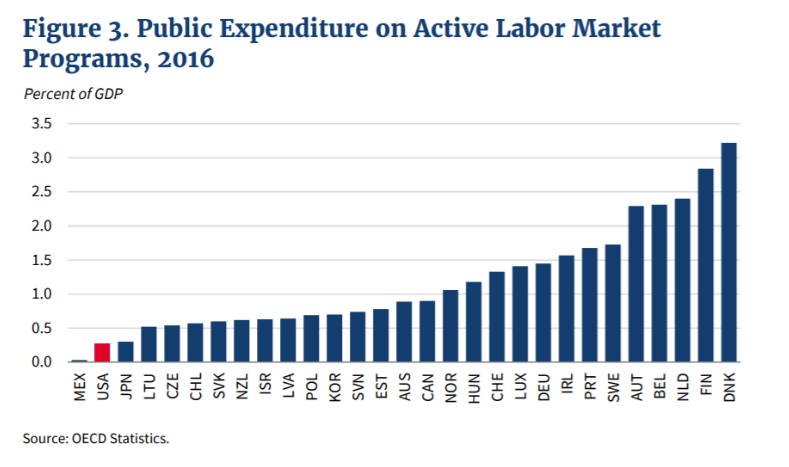Every few years, I review literature on productivity and automation. As a data scientist working in large enterprises, I have a front row seat to an emerging skillset that fits into our digital economy. As a former educator, I have a specific bias towards skill and capability development. These reviews are an attempt to understand some of the prevailing economic forces today, and identify the best next steps forward for creating opportunity for all.
This article highlights current efforts at varying levels of government, as well as a call for more modern active labor policies. The article closes with organizations and individuals for taking action.
Many efforts are taking place, at a variety of levels, to address skill development
Federal Programs
The Trump White House has supported the expansion of apprenticeship programs and is now pressing legislation to increase access to technical education, most notably through the Perkins Career and Technical Education bill. President Trump has also pushed forward an Executive Order focused on “workforce development,” by establishing the National Council for the American Worker and the American Workforce Policy Advisory Board. Adding to such ad hoc efforts, the administration has promised to develop a concerted strategy for “training and retraining” workers for “high-demand industries.”
State and Local Programs
Particularly with low relocation rates, local governments and businesses must work together to raise the welfare and living standards of their communities. A few examples of how these partnerships have formed:
- Colorado’s “Skillful” initiative is a statewide job skills program aimed at advancing “middle-skills jobs,” such as IT or advanced manufacturing, by connecting employers, State and Federal government, educators, businesses, and other key labor market players. In June 2017, Microsoft Philanthropies announced an almost $26 million investment in Skillful which would accelerate the workforce training program’s expansion into nineteen states beyond Colorado.
- Individual corporations are also taking initiative as well. As part of a 2013 deal to keep tens of thousands of jobs in the Puget Sound area, Boeing secured a commitment from the state of Washington to bolster science, technology, engineering and mathematics curriculum in public schools.
NGO and Multilateral Programs
As a separate entry point to the problem, national NGOs and trade associations are working to facilitate connections in their chapters’ local communities. A few examples of how these partnerships have formed:
- The American Association of Community Colleges endorse this multilateral approach and have created programs to facilitate partnerships, called the “Creating Connections in Manufacturing Communities with Community Colleges” initiative. The objective is to help programs bridge skills gaps and promote model programs to showcase the innovation and adaptability that community colleges can provide to support their industry partners and help their students thrive in the ever-changing job market.
- Manufacturing organizations, an area that needs to prioritize skills development, are forging long-term partnerships with public education, industry associations, and agencies to develop programs that build a strong connection with the industry, creating a skilled talent pool for tomorrow’s manufacturing environment. “The employer community is very aware of the need to start talking to late elementary school kids. Now that’s a long time to wait for your workforce,” the Manufacturing Institute’s Lee said. (emphasis mine)
- Platform to Employment (P2E) is another example of a nonprofit dedicated to assisting workers facing barriers to employment. P2E supports workers’ training and offers placement in a paid eight-week employment program.
More effort is required from active labor market programs to support this transition
Reskilling, in some ways, fits into a portfolio of public investments in education and workforce development already in place. However, Federal, State, and local governments in the United States have historically spent far less on such active labor market policies (such as public expenditures on retraining as well as on job counseling and job search assistance, as defined by the OECD), measured as a share of gross domestic product (GDP), than other developed countries.

Efforts to tie retraining to unemployment insurance, as Germany now does, have foundered. Federal funding, largely through Pell grants, often excludes those who have too much education—or too little. Pell grants also fail to address worker concerns over lost income while learning. The Labor Department’s Trade Adjustment Assistance program offers help in this regard, but on a smaller scale than needed, not least because restrictions on eligibility limit participation only to those who have lost their jobs to import competition, or because their jobs were shipped overseas. Several Democratic senators have submitted amendments to TAA to include those affected by automation. This has been introduced with no actions for ~1.5 years. And federal spending on workforce development through the Workforce Opportunity Investment Act (WIOA) is only about $1 billion (the remainder of the $3.3 billion in WIOA spending is allocated to disability and youth programs)
Done well, these programs can boost productivity and reduce the cost of such transitions on society. For example, in Sweden, workers have remarkably low unemployment durations, in part due to the assistance from economy-wide job security councils that provide transition services to displaced workers through career counseling and job search assistance, as well as assistance targeting retraining programs. The programs are funded by employer payroll taxes and serve as a sort of social insurance that spreads the risk of job losses across employers and, ultimately, across workers and consumers who will also bear the burden of higher payroll taxes.
The Business Roundtable, an organization of prominent American CEOs, have also made calls to improve investments. One of their current primary initiatives, titled “Time to Align,” calls for addressing the “skills gap” in the American economy and highlights that Federal funding for job training has decreased by 75% (from $24B to $5B) over the last four decades.
Ways to take action
The “skills gap” is a costly and challenging problem - modern, valuable capabilities are being developed in a few “superstar firms”, creating significant wealth and opportunity for some, and stagnant or declining opportunity for many. Closing the “skills gap” is a focus on democratizing these skills - helping a broader set of businesses become more competitive and rising wages for individuals.
For those who want to get involved, I recommend focusing on one of four key components for addressing America’s “skills gap”:
- Transparency in credentialing
- Employer-led investments
- Education as a Benefit;
- Tuition-Assistance Programs;
- U.S. Chamber of Commerce Foundation’s Talent Pipeline Management (TPM) Initiative
- Government multilateral partnerships
- Active labor market policies
For a more in-depth review of reskilling efforts, I also recommend the Council of Economic Advisors’ “Addressing America’s Reskilling Challenge.” For understanding how a multi-pronged effort can spur transformation, one can follow Mayor Pete Buttigeg’s efforts in South Bend, Indiana. During his time as Mayor, Pete Buttigeg chaired the US Conference of Mayor’s Task Force on Automation and partnered with the Drucker Institute on their “City of Lifelong Learning” initiative.
